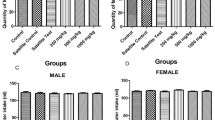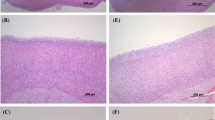Abstract
In this study, we aim to determine the median lethal dose (LD50) of glyphosate isopropylamine salt (GI), which is commonly used in the world and especially in Turkey against to weeds, in male and female rats by using the probit or logit analysis method. A total of 140 Wistar rats were used, including 70 females and 70 males. To determine LD50, the male and female rats were randomized into 7 groups made up of 10 animals in each group. At doses of 6000, 6500, 7000, 7500, 8000, 8500, and 9000 mg / kg, GI was administered to the male and female rats by oral gavage. After dosing, the animals were periodically monitored for 14 days. No deaths were observed after 48 h of herbicide application. In this study, only logit analysis was used for the LD50 value to be calculated in the male rats within 24 h, while other analyses were carried out with the probit method. In the female and male rats, the LD50 levels of GI between 24 and 48 h were determined as 7444.26–7878.50 mg/kg and 7203.58–7397.25 mg/kg, respectively. According to these results, it was concluded that female rats are more sensitive to GI than male rats. We believe that the findings that were obtained will guide researchers, clinicians, and toxicologists through preventive and curative studies against acute poisoning that may occur with GI.




Similar content being viewed by others
References
Alp H, Pinar N, Dokuyucu R et al (2016) Effects of intralipid and caffeic acid phenyl ester (CAPE) against hepatotoxicity and nephrotoxicity caused by glyphosate isopropylamine (GI). Eur J Inflamm 14:3–9. https://doi.org/10.1177/1721727X16630318
Atkinson D (1985) Toxicological properties of glyphosate-a summary. In: Grossband E, Atkinson D (eds) The herbicide glyphosate. Butterworths & Company, London, pp 127–133
Bradberry SM, Proudfoot AT, Vale JA (2004) Glyphosate poisoning. Toxicol Rev 23:159–167
Chandra M, Raj J, Dogra TD et al (2014) Determination of median lethal dose of triazophos with DMSO in Wistar rats. Asian J Pharm Clin Res 7:64–67
Dar MA, Sultana M, Mir AH et al (2018) Sub-acute oral toxicity of Roundup® and ammonium nitrate with special reference to oxidative stress indices in Wistar rats. Indian J Anim Res 52:405–408. https://doi.org/10.18805/ijar.v0iOF.7826
Doğan İ, Doğan N (2015) Statistical methods for estimating the LD50 in quantal bioassay: review. Turkiye Klin J Biostat 7:39–46. https://doi.org/10.5336/biostatic.2014-41688
Durkin PR (2011) Glyphosate: human health and ecological risk assessment. SERA TR-052-22-03b 336
El-Tawil Mohamed F, Marzouk EMA (2015) Acute oral toxicities of three pesticides used in Egyptian rice farms to albino rats. Curr Sci Int 4:145–154
European Chemical Agency (2017) Glyphosate not classified as a carcinogen by ECHA. https://echa.europa.eu/-/glyphosate-not-classified-as-a-carcinogen-by-echa. Accessed 19 Feb 2019
European Food Safety Authority (2015) Conclusion on the peer review of the pesticide risk assessment of the active substance glyphosate. EFSA J 13:4206. https://doi.org/10.2903/j.efsa.2015.4206
Finney D, Tattersfield F (1952) Probit analysis. The syndics of the Cambridge University press, New York, USA
Gil H-W, Park J-S, Park S-H, Hong S-Y (2013) Effect of intravenous lipid emulsion in patients with acute glyphosate intoxication. Clin Toxicol 51:767–771. https://doi.org/10.3109/15563650.2013.821129
Gress S, Lemoine S, Puddu PE, Séralini GE, Rouet R (2015) Cardiotoxic electrophysiological effects of the herbicide Roundup® in rat and rabbit ventricular myocardium in vitro. Cardiovasc Toxicol 15:324–335. https://doi.org/10.1007/s12012-014-9299-2
Guyton KZ, Loomis D, Grosse Y, el Ghissassi F, Benbrahim-Tallaa L, Guha N, Scoccianti C, Mattock H, Straif K (2015) Carcinogenicity of tetrachlorvinphos, parathion, malathion, diazinon, and glyphosate. Lancet Oncol 16:490–491. https://doi.org/10.1016/S1470-2045(15)70134-8
Hamdaoui L, Naifar M, Mzid M, Ben Salem M, Chtourou A, Makni-Ayadi F, Sahnoun Z, Rebai T (2016) Nephrotoxicity of Kalach 360 SL: biochemical and histopathological findings. Toxicol Mech Methods 26:685–691. https://doi.org/10.1080/15376516.2016.1230918
Karadeniz H, Ketenci HÇ (2018) The importance of taking biological samples for forensic examination in emergency medical interventions: a case report
Martinez DA, Loening UE, Graham MC (2018) Impacts of glyphosate-based herbicides on disease resistance and health of crops: a review. Environ Sci Eur 30:2. https://doi.org/10.1186/s12302-018-0131-7
OECD (2008) Test no. 407: repeated dose 28-day oral toxicity study in rodents, OECD guidelines for the testing of chemicals, section 4
Özdamar K (2013) SPSS ile biyoistatistik, 9th edn. Nisan Publishers
Paramveer D, Chanchal M, Paresh M et al (2010) Effective alternative methods of LD 50 help to save number of experimental animals. J Chem Pharm Res 2:450–453
Parvez S, Gerona RR, Proctor C, Friesen M, Ashby JL, Reiter JL, Lui Z, Winchester PD (2018) Glyphosate exposure in pregnancy and shortened gestational length: a prospective Indiana birth cohort study. Environ Heal A Glob Access Sci Sour 17:1–12. https://doi.org/10.1186/s12940-018-0367-0
Republic of Turkey Ministry of Food Agriculture and Livestock (2019) 480 G/L Glyphosate Isopropylamin Salt. https://bku.tarim.gov.tr/AktifMadde/Details/388. Accessed 15 Feb 2019
Richmond ME (2018) Glyphosate: a review of its global use, environmental impact, and potential health effects on humans and other species. J Environ Stud Sci 8:416–434. https://doi.org/10.1007/s13412-018-0517-2
Roberts DM, Buckley NA, Mohamed F, Eddleston M, Goldstein DA, Mehrsheikh A, Bleeke MS, Dawson AH (2010) A prospective observational study of the clinical toxicology of glyphosate-containing herbicides in adults with acute self-poisoning. Clin Toxicol 48:129–136. https://doi.org/10.3109/15563650903476491
The Extension Toxicology Network (1996) EXTOXNET PIP - Glyphosate. http://extoxnet.orst.edu/pips/glyphosa.htm. Accessed 19 Feb 2019
Tizhe E (2012) Influence of zinc supplementation on the pathology of subchronic exposure of Wistar rats to glyphosate. Ahmadu Bello University, Zaira
Tizhe EV, Ibrahim NDG, Fatihu MY, Igbokwe IO, George BD, Ambali SF, Shallangwa JM (2014) Serum biochemical assessment of hepatic and renal functions of rats during oral exposure to glyphosate with zinc. Comp Clin Path 23:1043–1050. https://doi.org/10.1007/s00580-013-1740-6
Turkmen R, Demirel HH, Kabu M, et al (2019) Protective effects of resveratrol on biomarkers of oxidative stress, biochemical and histopathological changes induced by sub-chronic oral glyphosate-based herbicide in rats. Toxicol res (Camb) 238–245. https://doi.org/10.1039/c8tx00287h
USEPA (1993) EPA 738-F-93-011. Registration eligibility decision (RED) for glyphosate
USEPA (2016) Report on the 2016 U.S. Environmental Protection Agency (EPA) international decontamination Research and Development conference
Vandenberg LN, Blumberg B, Antoniou MN, Benbrook CM, Carroll L, Colborn T, Everett LG, Hansen M, Landrigan PJ, Lanphear BP, Mesnage R, Vom Saal FS, Welshons WV, Myers JP (2017) Is it time to reassess current safety standards for glyphosate-based herbicides? J Epidemiol Community Health 71:613–618. https://doi.org/10.1136/jech-2016-208463
Williams GM, Kroes R, Munro IC (2000) Safety evaluation and risk assessment of the herbicide roundup and its active ingredient, glyphosate, for humans. Regul Toxicol Pharmacol 31:117–165. https://doi.org/10.1006/rtph.1999.1371
Wunnapuk K, Gobe G, Endre Z, Peake P, Grice JE, Roberts MS, Buckley NA, Liu X (2014) Use of a glyphosate-based herbicide-induced nephrotoxicity model to investigate a panel of kidney injury biomarkers. Toxicol Lett 225:192–200. https://doi.org/10.1016/j.toxlet.2013.12.009
Acknowledgments
A short summary of this study was orally presented at the 3rd International Scientific Research Congress (UBAK), 09–12 September 2018, in Kozaklı/Nevşehir, Turkey. The authors are thankful for the support of Afyon Kocatepe University Scientific Research Projects Coordination Unit and Laboratory of Experimental Animals Research and Application Center of Afyon Kocatepe University.
Funding
The study was supported by a grant from the Afyon Kocatepe University Scientific Research Projects Coordination Unit (Project no: 18.KARİYER.125).
Author information
Authors and Affiliations
Contributions
Ruhi Turkmen and Ilkay Dogan contributed equally to this work.
Corresponding author
Ethics declarations
Conflict of interests
The authors declare that they have no conflict of interest.
Ethical approval
This study was approved by Afyon Kocatepe University Animal Experiments Ethics Committee (No: 31/32; Date: March 13, 2018)
Additional information
Responsible Editor: Philippe Garrigues
Publisher’s note
Springer Nature remains neutral with regard to jurisdictional claims in published maps and institutional affiliations.
Rights and permissions
About this article
Cite this article
Turkmen, R., Dogan, I. Determination of acute oral toxicity of glyphosate isopropylamine salt in rats. Environ Sci Pollut Res 27, 19298–19303 (2020). https://doi.org/10.1007/s11356-020-07643-5
Received:
Accepted:
Published:
Issue Date:
DOI: https://doi.org/10.1007/s11356-020-07643-5




